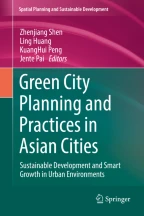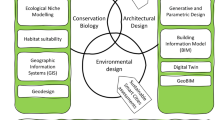Ecological Wisdom in the Planning and Design of Ancient Chinese Cities and Its Contemporary Relevance

Ancient Chinese urban civilization has a long history. Many ancient cities were designed with ecological wisdom with regard to the site selection, the space patterns, and the urban forms of the cities, adapted to geomorphological agents, hydrological features, and climate states; thus, natural ecological services could be better utilized in urban activities to create comfortable urban environments. By means of city historical maps and local chronicle data, this chapter analyzes the relation between site selection, space patterns, and building clusters of typical cities in ancient China and the terrain, hydrology, and climate. This analysis shows that these cities have a good relation of adaptability to nature, so that the urban space coordination ecological wisdom of “skillfully utilizing natural ecological resources and creating coordination between nature and human beings” with appropriate street directions, building orientation, and building cluster forms are selected according to different climates to create comfortable temperature and wind environments. This ancient ecological wisdom needs to be blended into contemporary urban planning and design to realize the coordination between urban construction and natural systems. Urban land expansion and urban form planning and design need to conform to natural ecological process rules. Manmade landscapes and natural landscapes need to be blended to realize the balance between urban processes and natural evolution processes and basically maintain regional ecological stability.
This is a preview of subscription content, log in via an institution to check access.
Access this chapter
Similar content being viewed by others

The Historic Urban Landscape and the Metropolis
Article Open access 30 December 2018

Smart Sustainable Cities of the New Millennium: Towards Design for Nature
Article Open access 25 August 2021

Landscape-Based Urbanism: Cultivating Urban Landscapes Through Design
Chapter © 2022
References
- Cai F (1987) Study on Beijing ancient canal and urban water supply [M]. Beijing Publishing House, Beijing Google Scholar
- Fu C et al (2009) History of China city’s development [M]. Social Sciences Press, Beijing Google Scholar
- He Y (1996) History of Chinese ancient urban planning [M]. China Building Industry Press, Beijing Google Scholar
- Hou R (1988) Beijing historical map collection [M]. Beijing Publishing House, Beijing Google Scholar
- Hou R (2005) About Beijing in Hou Renzhi’s eyes [M]. Beijing Publishing House, Beijing Google Scholar
- Hou R (2009) Life’s imprint in Beijing [M]. Life/Reading/New Knowledge Sanlian Bookstore, Beijing Google Scholar
- Li L (2009) Layout and geographical basis of Xi’an [M]. People’s Publishing House, Beijing Google Scholar
- Lin Z (2011) History of ancient cities in Hangzhou [M]. Zhejiang People’s Publishing House, Hangzhou Google Scholar
- Ma B (1999) Beijing Quadrangle Courtyard building [M]. Tianjin University Press, Tianjin Google Scholar
- Shi N (1995) Historical evolution of Terrain in Xi’an [J]. Chinese Historical Geography, 1995, 04 Google Scholar
- Shi N (1996) Xi’an historical map collection [M]. Xi’an Map Publishing House, Xian Google Scholar
- Shi N (1999) Longshouyuan and Chang’an in the Sui and the Tang dynasties [J]. Chinese Historical Geography 1999, 04 Google Scholar
- Yang K (1993) Study on history of ancient Chinese capitals [M]. Humanities & Social Sciences, Beijing Google Scholar
- Yu S (1980) Masterpiece of planning and design of ancient Chinese cities—Suzhou map [J]. J Archit 1980(01):15–20 Google Scholar
- Yu S (1986) Discussion on water system problem in planning of Chinese cities from Suzhou [J]. J Archit 1986(09):37–42 Google Scholar
- Zhong Y (1982) About Hangzhou [M]. Zhejiang People’s Publishing House, Hangzhou Google Scholar
- Zhou F (1997) Hangzhou in the Southern Song Dynasty [M]. Zhejiang People’s Publishing House, Hangzhou Google Scholar
- Zhou L (2010) Comparison and study on diachronic growth and evolution and space form of ancient city of Lijiang [J]. Study Urban Dev 2010(07):106–112 Google Scholar
- Zhu S (1984). Macro geographical situations and micro geographic features in Chang’an [A]. Society of Chinese ancient capital. Chinese ancient capital research, vol II. In: Proceedings of the Second Annual Meeting of the Society of Chinese Ancient Capital [C]. Society of Chinese Ancient Capital, 1984: 13 Google Scholar
- Zhu S (1990) Chang’an–Beijing comparison and research on the most important ancient capitals in China [J]. Chinese ancient capital research. In: Proceedings of the eighth annual meeting of the Society of Chinese Ancient Capital, 1990, 08 Google Scholar
Acknowledgments
The authors thank the Planning Exhibition Hall and the Planning Bureau for providing useful information.
Author information
Authors and Affiliations
- School of Architecture and Urban Planning, Chongqing University, Chongqing, China Yan Shuiyu, Yang Huihui, Xu Lijuan & Ren Tianman
- Yan Shuiyu



